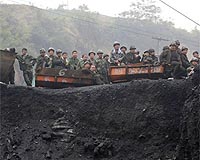| . |  |
. |
Xiangning, China (AFP) March 29, 2010 Rescuers raced Tuesday to find 153 workers trapped in a flooded coal mine in northern China, as workers angrily accused mine management of ignoring warning signs of the impending disaster. Two days after water gushed into the vast Wangjialing mine in Shanxi province, China's coal-producing heartland, the fate of the workers still missing after Sunday's accident remained unclear. But officials warned toxic gas was building up in the pit, posing a threat to both the men trapped inside and rescuers trying to drain the mine in the latest incident to strike the notoriously dangerous industry. If the missing are not rescued, the accident in rugged Xiangning county will be the deadliest in China in more than two years. In August 2007, 172 workers died in a mine flood in the eastern province of Shandong. Liu Dezheng, vice-director of the Shanxi Work Safety Administration, told reporters late Monday that 970 rescuers were involved in the rescue effort. "The coal mine has a high concentration of gas. Rescuers have to face the danger of toxic gas, while fighting the water," he said. "We must guard against secondary disasters." Co-workers of the missing angrily accused mine officials of ordering them back into the half-built pit, even after water was discovered leaking into the mine on Thursday -- three days before the accident. "Water continued to seep in in the days afterwards and we reported it, but there was no order to evacuate. Why didn't they do something about that?" a mine construction worker who gave only his surname, Shi, told AFP. After a one-day shutdown on Saturday, workers said they were ordered back in on Sunday -- the day of the accident. "A lot of workers didn't want to go back in because of the water leaks. But when your shift goes in, you can't refuse. You have to go," a worker surnamed Jiang said. Beijing has ordered local authorities to go all-out to find the workers at the massive mine, which belongs to the state-owned Huajin Coking Coal Company and covers an area of 180 square kilometres (70 square miles). Investigations so far have shown that 261 workers, mainly migrant workers from other provinces, were in the mine as water started to gush in. Officials said 108 were brought to safety. The China Daily newspaper quoted workers saying they believed even more men could be in the flooded pit. "Those trapped are my workmates. I just want to try my best to save them," said one 40-year-old worker surnamed Xu, who told Xinhua news agency he had worked through the night to help position drainage equipment. However, some complained about the mine's lack of preparedness for the disaster. State media reports have said some pumping has begun but was proceeding slowly after authorities had to rush in additional pumping and drainage equipment. The mine did not have such equipment as it was not yet open. "Why are they not pumping the water? They have got to start pumping the water and find these people," said a woman who gave her surname as Zhang, and who said three of her relatives were missing. A preliminary probe showed water that had accumulated in nearby abandoned mines burst into the new pit, flooding it with enough water to fill about 50 Olympic-sized swimming pools. "To survive down there around 1,000 metres underground would be very lucky," survivor Fan Leisheng told state television on Monday. The colliery, presented as a first-class model of safety and efficiency on Huajin's website, was due to produce six million tonnes of coal a year. Huajin itself is half-owned by China National Coal Group Corp, the country's second-largest coal producer and parent of Hong Kong-listed China Coal Energy. Mines in the world's top coal-producing nation are among the most dangerous globally. More than 2,600 people were killed in the country's collieries last year, according to official figures.
Share This Article With Planet Earth
Related Links Surviving the Pits
 At least 152 trapped in flooded China coal mine: Xinhua
At least 152 trapped in flooded China coal mine: XinhuaBeijing (AFP) March 28, 2010 At least 152 workers were trapped in a coal mine in northern China on Sunday after it flooded, state media reported, in the latest incident in the country's hazardous mining industry. A total of 261 miners were working in the pit when the accident took place Sunday afternoon in Shanxi province, and just over 100 of them managed to escape while the others remained trapped, the official Xinhua ... read more |
|
| The content herein, unless otherwise known to be public domain, are Copyright 1995-2010 - SpaceDaily. AFP and UPI Wire Stories are copyright Agence France-Presse and United Press International. ESA Portal Reports are copyright European Space Agency. All NASA sourced material is public domain. Additional copyrights may apply in whole or part to other bona fide parties. Advertising does not imply endorsement,agreement or approval of any opinions, statements or information provided by SpaceDaily on any Web page published or hosted by SpaceDaily. Privacy Statement |